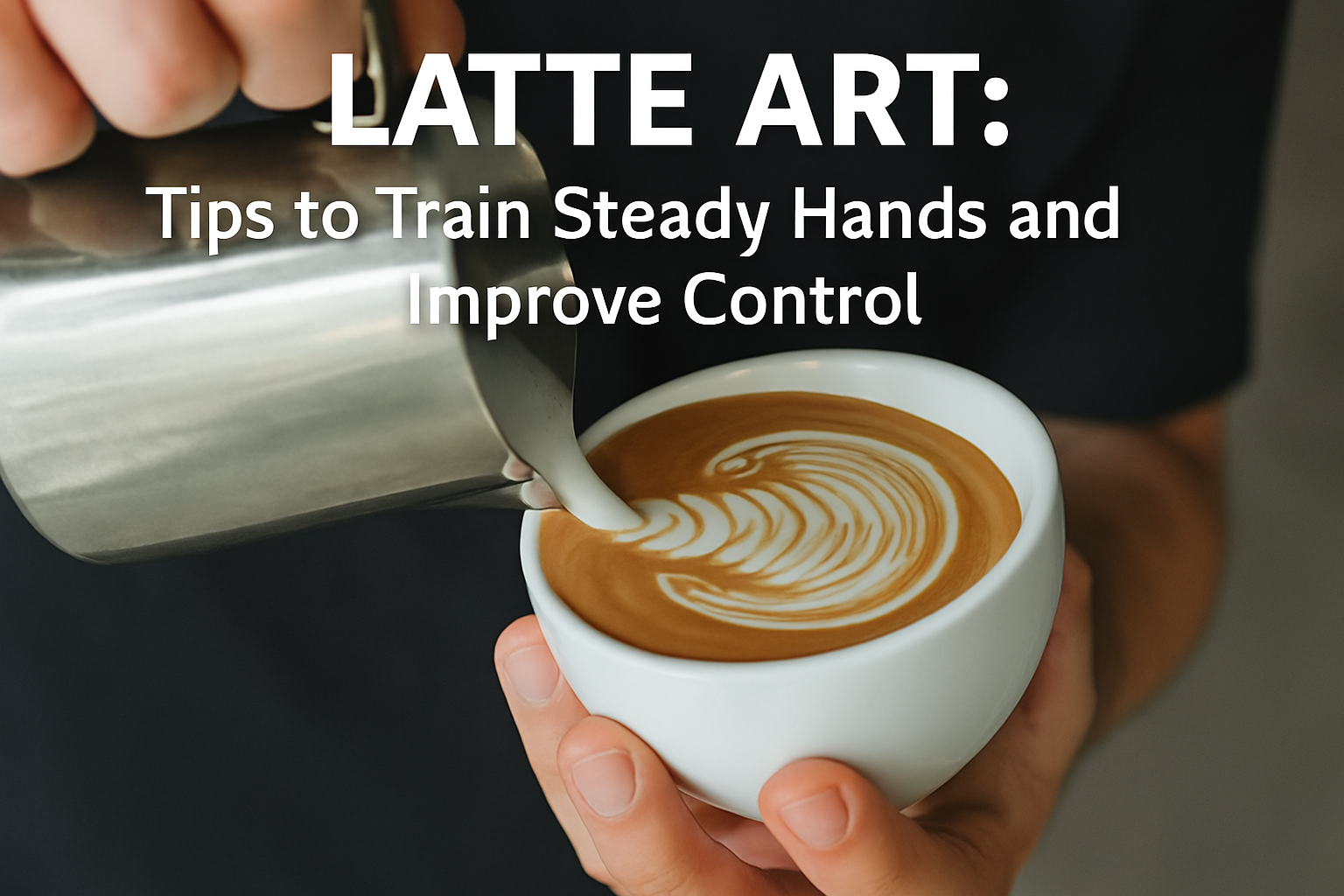Creating clean, balanced latte art isn’t just about milk texture and espresso quality — it’s also about control. A steady hand can mean the difference between a sharp heart and a messy blob, or a defined rosetta and a broken line.
Whether you’re a beginner or an experienced barista, improving your hand stability and motor control is essential for pouring with consistency and confidence.
In this guide, you’ll find practical tips, exercises, and strategies to develop steady hands and elevate your latte art game.
Why Hand Control Matters in Latte Art
Latte art is a craft of fluid motion. Your hand is responsible for managing:
- Pitcher height
- Pour speed
- Pour direction and angle
- Timing of design elements
If your hand shakes or moves inconsistently, the foam will flow unevenly and distort your design. On the other hand, if your movements are smooth and deliberate, your designs will look sharp and professional.
Steady hands lead to cleaner lines, better symmetry, and greater repeatability.
Understand the Source of Unsteady Hands
Before you start training, identify why your hands may be unstable. Common causes include:
- Tension in the wrist, shoulders, or fingers
- Fatigue from holding the pitcher too tightly
- Lack of confidence or nervousness
- Pouring too quickly out of habit
- Improper posture or poor grip
Recognizing the cause helps you choose the right corrective strategies. For most baristas, it’s a mix of physical and mental factors.
Tip 1: Start With the Right Grip
The way you hold your milk pitcher directly impacts your control. Avoid gripping it like a hammer — it creates tension and limits flexibility.
Best Grip Technique
- Place your thumb on top of the handle
- Wrap your index finger around the side
- Rest your other fingers underneath for support
- Keep your wrist neutral and relaxed
This grip allows for micro-movements and finer adjustments, especially when pouring close to the surface.
Experiment with what feels most stable, but avoid holding too tightly — tension increases shaking.
Tip 2: Focus on Body Position
Your whole body contributes to your hand control. If you’re off-balance or leaning awkwardly, it’s harder to keep your movements steady.
Ideal Position
- Stand with both feet flat and shoulder-width apart
- Keep your shoulders relaxed and level
- Position the cup close to your body
- Tilt the cup slightly toward you — about 20–30 degrees
- Pour with your elbow slightly tucked in
Keep the pitcher aligned with your center line for better control. Avoid overreaching or twisting your torso while pouring.
Tip 3: Practice Holding Still
If your hands shake while pouring, start by improving your ability to hold them still.
Holding Exercise
- Fill your pitcher halfway with water
- Hold it at pouring height over a dry cup
- Try to keep it still for 10–15 seconds
- Gradually increase the time each day
You can also place a coin on top of the pitcher handle and try not to let it fall. This builds stability and awareness of your micro-movements.
Tip 4: Slow Down Your Pour
Many beginners pour too quickly, trying to finish the drink fast. But speed sacrifices control.
How to Slow Down
- Count to 3 while pouring the base (high pour)
- Count to 5 while creating the shape (low pour)
- Count to 2 for the cut-through
Deliberate pacing builds muscle memory. It also gives you time to adjust positioning mid-pour without panicking.
Slower pouring doesn’t mean dragging — it means controlled motion at a consistent rate.
Tip 5: Use Two Hands While Practicing
When you’re just starting or working on precision, use both hands for support.
Hold the pitcher with your dominant hand and place your non-dominant hand under your wrist or pitcher bottom to guide motion.
This stabilizes your pour and reduces shake. As your muscles develop better control, transition back to single-handed pours.
Tip 6: Strengthen Your Wrist and Fingers
Hand and wrist strength affect stability. Weak muscles are more prone to fatigue and tremors during long shifts.
Wrist Strengtheners
- Wrist curls using a light dumbbell
- Finger extensions with a rubber band
- Squeezing a stress ball for 10 seconds at a time
- Writing or drawing slowly to build fine motor control
Do these exercises 3–5 times per week for noticeable improvement.
Tip 7: Practice Dry Pours
Not every training session needs milk. Dry pours save ingredients and allow focused practice.
Try This
- Fill a pitcher with water
- Use food coloring or soy sauce in another cup to mimic crema
- Practice your movements, shapes, and flow rate
Water pours won’t replicate foam behavior, but they help build rhythm, angles, and motor control without pressure.
Tip 8: Breathe and Relax
Anxious or stiff baristas are more likely to shake. It’s common to hold your breath while focusing, but this increases tension.
Breathing Technique
- Take a deep breath before you begin
- Exhale slowly as you pour
- Keep your shoulders low and jaw unclenched
The calmer your body, the steadier your hands. Consider warming up with 1–2 mindful breathing cycles before service or training.
Tip 9: Use Visual Guides
Some baristas place a dot or line at the center of their cup (using cocoa or a tiny drop of milk) to serve as a visual anchor while pouring.
This helps your eyes stay focused and guides your hands to keep the design centered.
Over time, your eyes and hands will naturally align without needing these marks.
Tip 10: Record Yourself Pouring
One of the most effective ways to improve is by watching yourself. Use your phone to record a few pours from the side and top angles.
Look for:
- Shaky hand movements
- Inconsistent pour height
- Jerky cut-throughs
- Sudden speed changes
This gives you direct feedback and helps track your improvement over time.
Tip 11: Practice With Intention
Mindless repetition won’t make you better. Focus on one variable per practice session.
For example:
- Today: focus only on pitcher height
- Tomorrow: focus on pour speed
- Next session: focus on cut-through technique
Intentional practice leads to faster and more lasting improvement.
Tip 12: Rest and Stretch
Hand fatigue is real, especially in high-volume environments. Without recovery, your muscles tighten and shake more easily.
Stretching Routine
- Wrist flexor stretch: Hold fingers and pull gently back
- Wrist extensor stretch: Push palm downward with opposite hand
- Finger spread: Stretch fingers wide for 10 seconds, repeat
Take breaks between shifts or training sessions. Shake out your arms, stretch, and reset posture.
Bonus Tip: Improve Core Stability
It might surprise you, but core strength affects arm control. A stable core keeps your whole upper body steady.
Try adding light planks, yoga, or resistance training to your weekly routine to improve body control overall.
Better core strength reduces unintentional swaying and stabilizes your pouring platform.
Common Mistakes That Lead to Shaky Hands
Even with good intentions, these habits can hurt your control:
- Holding the pitcher too tightly
- Pouring from too far away
- Keeping the cup too far from your body
- Forgetting to breathe
- Practicing too long without rest
Correcting these small things can bring big improvements quickly.
When to Expect Results
Consistency beats intensity. You won’t fix unsteady hands overnight, but with daily practice and attention, most baristas see significant improvement in 2–4 weeks.
Track your progress by:
- Taking photos of your designs
- Recording videos of your pouring
- Writing down how steady your hand feels each session
Celebrate small wins like smoother lines or better symmetry — these are signs of growing control.
Final Thoughts: Steady Hands Create Confident Pours
Latte art is a performance of precision. The beauty in your cup starts with the control in your hand. It’s not about being naturally steady — it’s about training your body and mind to move with focus.
Every small step you take to improve hand control brings you closer to cleaner designs, better contrast, and consistent results.
Be patient. Be intentional. And keep pouring — one steady hand at a time.

Marcelo Rodrigues is a passionate barista with over 7 years of experience in specialty coffee. He’s worked in top cafés, led barista training sessions, and now shares practical tips to help beginners and coffee lovers improve their skills. Through this blog, Marcel makes the world of coffee more accessible—one cup at a time.

